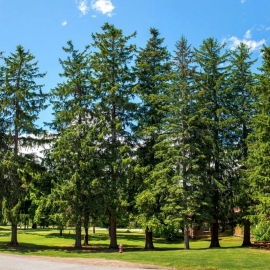


Organic Norway Spruce Seeds (Picea abies)
1.14 €
The Norway Spruce is a valuable timber and shelter belt tree and is the classic Christmas tree, consumed in countless millions. It is a tough and vigorous tree that is not prone to serious attacks from pests and diseases.
-
Organic Norway Spruce (Picea abies)
The Norway Spruce is a valuable timber and shelter belt tree and is the classic Christmas tree, consumed in countless millions. It is a tough and vigorous tree that is not prone to serious attacks from pests and diseases.
It's dense natural habit provides year round shelter for many birds and mammals. The seeds are eaten by birds such as the goldcrest and long tailed tit and also red squirrels.
This is quite an adaptable tree that can grow well on both clay soils and sandy ones. It prefers a deep loam soil (as do most plants!) in an area with rainfall of at least 510mm (20") but preferably 900mm (35+") per year. They prefer an acid soil with a pH between 5 and 7.5 but will grow with reduced vigour and density on soils with a pH level higher than this.
Generally speaking this is not an especially long lived tree with specimens over 200 years old being rare. However in 2008 a specimen named Old Tjikko found on Fulu Mountain in the Dalarna province of Sweden was found by carbon dating its roots to be 9550 years old.
Scientists have in this area identified a cluster of Norway Spruce trees over 8000 years old. These trees have been able to survive the harsh tundra type conditions by possessing the ability to keep regrowing a new trunk when the existing one died to produce a tufty looking bushy shrub.
For germination the seeds require a period of moist pre-chilling also known as stratification before the seeds should be sown, this takes around 6 weeks in the fridge and is not difficult to do!
How to Grow
Norway Spruce seeds are relatively easy to germinate and grow. The dormancy within the seed is short and easily broken and reasonable success can be expected even when seeds are sown without any form of pre-treatment. The benefit of a short period of pre-treatment is that a greater percentage of seeds will germinate and the germination of the seedlings will be syncronised with most seedlings germinating within a few days of each other.
Soak the seeds in water for 24 hours. Fully drain away all of the water and place the seeds in a zip-lock freezer bag. Place the seeds in the fridge, it is important that during this period that the seeds do not dry out or are waterlogged otherwise the pre-treatment will be ineffective.
t is important to keep checking the seeds every week or so to make sure that they are not drying out. You could also at the start of treatment incorporate a little damp vermiculite or perlite, this helps to keep the seeds moist but not waterlogged.
After around 4 weeks under these conditions the seeds are ready to be sown. Seeds should be sown into containers filled with a good quality general potting compost. Suitable containers could be plant pots, seed trays or plug trays or even improvised containers with drainage holes. Firm the compost gently and sow the seeds on the surface. If you are sowing in plug trays, sow 2 or 3 seeds per cell.
Cover the seeds with a couple of millimeters of vermiculite or failing that a fine layer of sieved compost. Follow with a gentle watering and keep them at room temperature. Germination will begin within a 10-14 days of sowing.
The seedlings are reasonably robust and trouble free and usually grow to a height of between 2 and 10 cm in the first growing season depending on the sowing date and cultural techniques.
Developing seedlings should be fine in full sun, keep them well watered and free of competing weeds.
Growth will accelerate in the second and subsequent years and the developing young trees should be re-potted as necessary preferably during the dormant season. After perhaps 2 or 3 years they are ready to be planted in their permanent position
